 66th IFLA Council and General
Conference
Jerusalem, Israel, 13-18 August
Code Number: 068-165-E
Division Number: II
Professional Group: Art Libraries
Joint Meeting with: -
Meeting Number: 165
Simultaneous Interpretation: No
Cataloging artist files: one library's approach to providing integrated access to ephemeral material
Daniel Starr
Technical Services and Planning
The Museum of Modern Art
New York, USA
E-mail: daniel_starr@moma.org
Paper
Description of the problem
Ephemeral material often contains important documentation on artists that is not easily found anywhere else. It documents obscure artists and the early careers of well-known artists. It is not widely distributed, but many libraries have important collections of this material, often concentrating on local artists and on material produced by local galleries and museums.
Ephemeral material is rarely cataloged, and even if it is the cataloging information may not be in on-line databases which may be searched over the Internet. Many libraries create a card catalog listing files on individual artists or rely on simply going to the filing cabinets to see if a file exists. This makes discovering which repository has information time-consuming, since it is often difficult to predict which library has collected and preserved ephemeral material about a particular artist.
No one disputes the value of a unified database of information about artists, but it is difficult to provide this, even within our own institutions. How can we accomplish this admirable goal given our perpetual understaffing and overwork?
Creating a database is a substantial investment in time, but any time spent on one may be repaid by removing hidden burdens in using artist files. Library staff or researchers can predict which files exist before making a trip to a library or to the filing cabinets. Cataloging records provide security, both in identifying the existence of files, and in helping control circulation of the material if that is allowed. Finally, by highlighting the types of information contained in files, catalog records may help in identifying later preservation or digitization projects, for example, by identifying files that contain photographs or slides that may need special housing or that might be candidates for digitization.
Description of one approach to a solution
This paper will demonstrate how cataloging for a collection of over 40,000 files on individual artists is made available to researchers around the world by incorporating MARC records for each file in an on-line catalog that can be searched over the internet. While each library handles this material in different ways, the approach presented in this paper may provide one example that will help begin the process of creating an international automated catalog of artist files.
The Museum of Modern Art Library has approached cataloging artist files by attempting to provide an appropriate level of cataloging information. We judge what is appropriate by balancing the importance of the files for research against the time required to catalog them. While we can never hope to describe the contents of each file completely we attempt to make sure that the information we do provide is in accordance with national cataloging rules and apply appropriate MARC coding. This allows these records to be integrated in a catalog of more traditional library materials, and means that they could be shared with other libraries, or an international database of artists.
We began with an existing list of artist files that was created when the microform vender Chadwyck-Healey microfiched the contents of our artist files in the 1980s.
Example 1. Existing list of artist files

Unfortunately, at the time that this index was created no one in the library thought to obtain a copy of the electronic file that was used to print the list. Rather than retyping all of this information we had this list scanned and ran it through an OCR program. Once this electronic file was edited we had a record of all of our files created before the 1980s.
Since the 1980s we had maintained a list of new files in a Word document. (This list was actually used to produce cards to file into the card catalog.) We combined these two lists into one master list of names. These names were then merged with a template to create a unique MARC record for each artist. Our library automation vendor did this for us, but other methods could be used, including the simple MARCMakr program supplied by the Library of Congress (http://www.loc.gov/marc/marcutil.html).
Because each file was not examined during this process we could only describe the files in the most general way by identifying characteristics that they all shared. We included information about what might be in each file, but could not provide any specific information about the type or amount of information in each file, or even the dates of the information included.
Example 2. Artist file template

The resulting records were loaded in our automated system. At this stage we did not create "call numbers" but we added a phrase that indicated how researchers could request this material from our stacks. This is how these records look in our on-line catalog.
Example 3. Display of cataloging information in an on-line catalog

Volunteers with appropriate training and under supervision by library staff create new files. They type the artist's name into the author field (100) and then copy it into the fields for the subject (600) and for the call number (090). Since the files are arranged by the artist's name we put the name in the call number field.
Example 4. New record for an artist file that is keyed in
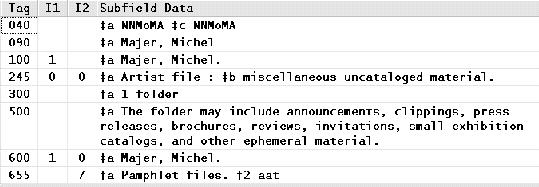
Currently, little attempt is made to keep the description of the content current, but since catalog entries in on-line catalogs are much easier to update than card files this information could, with enough staffing, be kept current. The number of folders or even the number of items in each folder could be updated, as well as the description of the contents.
More specialized material had additional form/genre terms added, and a more specific description of the contents of each file. We used this approach for two sets of files that we acquired dealing with political art and with artist bookmakers. Since these files are not active-we do not add to them-the description of the contents and of the time period of the contents could be indicated more specifically.
Example 5. Artist file in a specialized archive
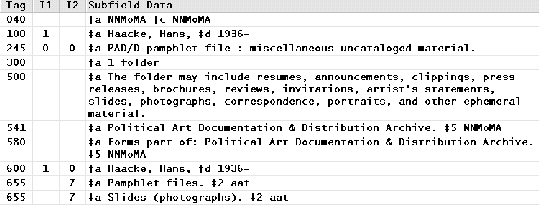
Example 6. Artist file in a specialized archive
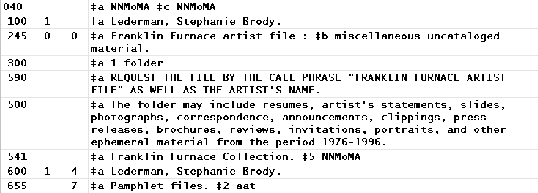
Not only do these records provide access to our artist files in our on-line catalog (available over the Internet at http://library.moma.org) but they also help us manage the growing collection. We have been able to use these records in our circulation system to record when a curator is using a file, or when we have had to move the original file to storage. In this case we rely on the microfiche for quick access, but will retrieve the original file with proper notice.
Example 7. Artist file record used to track location and circulation
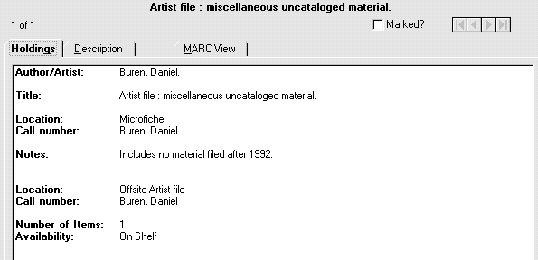
Another use for these records is to provide biographical information not normally included in cataloging records, especially when obituaries are clipped and filed.
Example 8. Artist file record used to record biographical information

Here is a case where the birth and death years are recorded in the 545 field (used for biographical data). We do not include this information in the headings for the artist (100 and 600) because we attempt to make all headings consistent with the Names Authority File maintained by the Library of Congress. This is one of the compromises that are required for having these records in an integrated catalog.
This approach of using templates and form/genre terms to describe artist files could be extended to cataloging other categories of materials that share similar characteristics.
We have used the same technique for auction catalogs…
Example 9. Auction catalog record created using a template

As well as for indexing MoMA, our member's magazine.
Example 10. Indexing created using a template
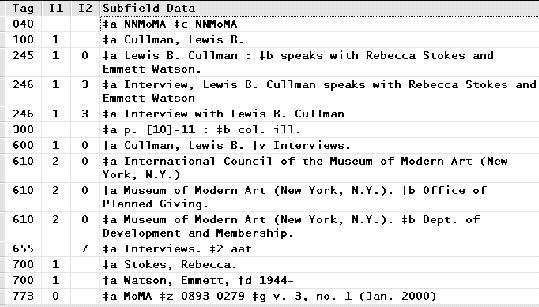
Conclusion
For libraries that have computerized catalogs the use of templates to create cataloging records may provide useful access to ephemeral materials without the demands of creating full cataloging records. This approach, while not perfect and certainly not traditional full cataloging, is a flexible way to create MARC records that might later be used to reach the goal of a unified, shared database of artist files. For libraries that do not yet have computerized catalogs the way that files are currently processed may be organized so that later conversion to computerized records is made easier.
| 





